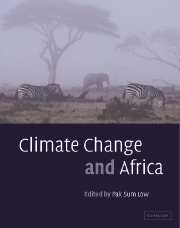Book contents
- Frontmatter
- Contents
- Notes on contributors
- Peer reviewers
- Editor's note
- Foreword
- Foreword
- Foreword
- Foreword
- Preface
- Preface
- Preface
- Preface
- List of abbreviations
- List of SI prefixes
- List of unit abbreviations
- List of chemical formulae
- Part I Science
- Part II Sustainable energy development, mitigation and policy
- Part III Vulnerability and adaptation
- Part IV Capacity-building
- Part V Lessons from the Montreal Protocol
- Index
Foreword
Published online by Cambridge University Press: 10 December 2009
- Frontmatter
- Contents
- Notes on contributors
- Peer reviewers
- Editor's note
- Foreword
- Foreword
- Foreword
- Foreword
- Preface
- Preface
- Preface
- Preface
- List of abbreviations
- List of SI prefixes
- List of unit abbreviations
- List of chemical formulae
- Part I Science
- Part II Sustainable energy development, mitigation and policy
- Part III Vulnerability and adaptation
- Part IV Capacity-building
- Part V Lessons from the Montreal Protocol
- Index
Summary
The reduction of the snowcap of the mighty Mount Kilimanjaro by four fifths over the last 90 years is one of the most immediately discernible impacts of climate change in Africa, and irrefutable evidence of what is happening to our planet. Under the present trends, scientists tell us, the remaining ice fields on the mountain are likely to disappear between 2015 and 2020 (see Thompson et al. (2002): Science, 298, 589–593). If this were the case, there would be significant implications for the water resources of the African countries that are dependent on the melted water coming from the mountain. The integrity of already fragile ecosystems with their endemic species would suffer. In addition, a tropical peak without the snowcap would be far less attractive to the tourists who are the source of income for many local people.
Climate change will hit all nations directly or indirectly and its warming impact is likely to be strongest in areas near the poles. However, of all continents, human suffering as a consequence of climate change may well be most dramatic in Africa. This region has probably never faced in its history as formidable a challenge as adaptation to climate change, requiring the migration or transformation of not only natural (often already endangered) ecosystems, but also of agricultural production systems. The Africans can do little themselves to prevent the climate change, which has not, for the most part, been caused by them.
- Type
- Chapter
- Information
- Climate Change and Africa , pp. xxviiPublisher: Cambridge University PressPrint publication year: 2005



